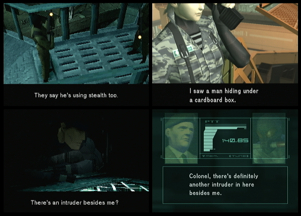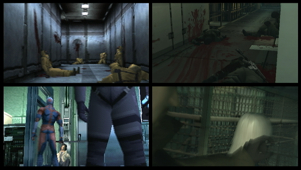|
The Scenario Map was more abstract than the Series Map. Though the player had
completed the Tanker Chapter's Player Objectives, he failed-by-proxy when
Snake had failed his Actor Objectives. MGS1 had trained the player to
expect redemption as a formal complement to failure, so he looked for those
formal elements in MGS2. Despite having lost control of Solid Snake,
the player expected that, through his actor, he would infiltrate a high-tech
industrial facility on a solo sneaking mission and discover a rival
infiltrator in the process.
MGS1 had delayed Snake’s encounter with his rival infiltrator,
thereby briefly preserving the illusion of a solo sneaking mission. MGS2’s
illusion broke as soon as the Plant Chapter began. In MGS1, Snake had swum into an underground dock, snuck past patrol guards, waited for an elevator to descend, boarded the elevator, and infiltrated an industrial military complex.
Raiden swam into a similar setting immediately after Solid Snake had knocked out the guards and boarded the elevator. While waiting for the elevator to return from Snake’s infiltration, a prudent player could stash the unconscious guards in lockers to prevent their waking
up, but MGS2 punished such prudence. If the guards were in lockers, the elevator took longer to descend.
MGS2 wanted the player to begin the Plant Chapter wading through Solid Snake’s mess, and it wanted him to hide when the guards awoke and started looking for
Snake. Raiden’s first steps in
MGS2 parodied the intensity of Snake’s in MGS1.
Snake’s role as Lieutenant Plisken in MGS2 formally recalled MGS1’s cyborg ninja, Gray Fox. In
MGS1, Snake and Gray Fox had dually trespassed without collusion. Snake
had overheard guards discussing a lethal infiltrator who used optical stealth camouflage, and he later learned the ninja’s identity after having walked through a bloody hallway lined with corpses. In
MGS2, Raiden and Snake dually trespassed without former collaboration. Raiden overheard the terrorists’ ranking officer report that she had seen a trespasser hiding under a cardboard box, and he first spoke with Snake after walking through a bloody hallway lined with corpses.
A detailed comparison bears out the formal similarities while also highlighting
how MGS2 thwarted the narrative expectations it had evoked. Gray Fox had taught Solid Snake how to fight, and Raiden had learned how to fight by emulating Solid Snake in virtual reality simulations; however, Snake had learned
from Gray Fox, and Raiden had learned as Solid Snake in VR. Gray Fox had used optical stealth camouflage which Snake lacked, whereas Snake used a cardboard box
in MGS2 that Raiden could use also. Snake had saved a helpless
scientist after watching Gray Fox slaughter enemy soldiers in MGS1’s
bloody hallway, whereas Raiden had been saved by MGS1’s hero after Vamp
slew soldiers on Raiden’s side in MGS2’s bloody hallway. After
the bloody corridors, Snake had learned the ninja’s true identity in
MGS1, while Raiden only learned Snake’s pseudonym.
Other formal elements led to opposite conclusions. Snake
was the reason that Gray Fox had infiltrated, while Raiden was incidental to
Snake’s mission. The ninja had appeared in
MGS1 first to confront and later to aid Solid Snake, yet Snake turned
from Raiden’s comrade into his apparent enemy. Gray Fox had sacrificed his
life to help Snake destroy Metal Gear Rex, yet Snake
sacrificed Raiden at MGS2’s climax. Snake delivered him to the terrorists as a distraction so he could sneak into an otherwise inaccessible area.
MGS2 compounded the narrative reversal of MGS1’s forms when its
cyborg ninja helped Snake subdue Raiden.
MGS2 formally evoked Snake’s relationship with Gray Fox—an element of the Scenario Map—yet denied the narrative
tension and catharsis that the form implied.
|


